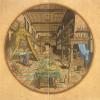Robert Fludd's Alchemical Philosophy and Medicine
Commentary
Image 1: Frontispiece of Robert Fludd's Anatomiae Amphitheatrum (1623). Source: Wellcome Collection. Copyright: CC BY 4.0.
Image 2: Illustration of Macrocosmic man, from Robert Fludd's Utriusque cosmi historia, 2nd volume: microcosmi historia (1619). Source: Wellcome Collection. Copyright: CC BY 4.0.
Robert Fludd (1574-1637) was an English physician, a MD from Oxford (1605), and member of the Royal College of Physicians (from 1606). He and William Harvey knew each other well; although the influence of Fludd on Harvey is still debated, Harvey was probably aware of Fludd's chief work, the monumental Utriusque cosmi historia (1617-1621) published in Frankfurt in two volumes. Certainly Fludd was the first to support the circulation of blood, calling Harvey his "friend, colleague and compatriot well versed not only in anatomy but also the deepest mysteries of philosophy."
Fludd held a grandiose view of the universe in which man, as the microcosm, mirrored the macrocosm. His vision was translated in a number of stunning symbolic illustrations, that drew inspiration from the work of Heinrich Khunrath but went even further in its intricacy. His theories of universal harmony seem to find correspondence on Harvey's insistence on the harmony of Nature and the latter's belief in the perfection of Nature. Both Fludd and Harvey subscribed to the heliocentric theory.
Fludd's alchemical philosophy was influenced by Paracelsianism; however, and as opposed to many hardcore Paracelsians, he was supportive of anatomy. This can be easily noted in the cover of his Anatomiae Amphitheatrum of 1623 (image 1), which describes his vision of a tripartite anatomy: as dissection (right hand-side), as alchemical separation (lower left hand-side), and as mystical contemplation (top).
During this period, the correspondence of the heart with the Sun was particularly advanced by alchemists and natural magicians, although it had ancient and medieval roots. Image 2 depicts this correspondence very plainly, showing the 'heart' (cor) and the 'Sun' (Sol) united by the same 'solar path' (Via solis). As can be seen in De motu cordis, Harvey also subscribed to this association.
Credit: Georgiana Hedesan
Huffman, W. H. (1988), Robert Fludd and the End of the Renaissance (Routledge).
Maclean, Ian (2004), 'Robert Fludd', in the Oxford Dictionary of National Biography (ODNB), available freely to Oxford students.

